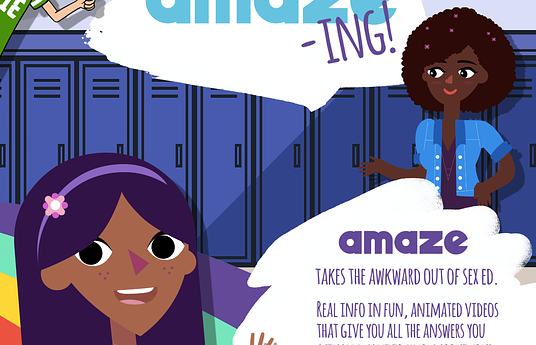In the United States, a record number of anti-LGBTQ bills have been introduced so far in 2023, with a total of 283 education-related bills introduced as of April. These bills include curriculum censorship bills that restrict education about gender and sexuality in public schools as well as “forced outing” bills that require teachers to report any changes in a student’s name or pronouns to their parents. These laws may have severely detrimental impacts on the mental health of LGBTQ youth, who are more than four times as likely to contemplate suicide than their heterosexual peers.
In the midst of these devastating challenges impacting LGBTQ youth, we spoke with Victoria Ogunleye, Digital Sex Education Manager with AMAZE.org at Advocates for Youth, about what can be done to support LGBTQ students.
AMAZE.org is an initiative of Advocates for Youth, that offers a free, video-based sexual health resource that uses short, animated videos to educate young people with honest, accurate sexual health information. These videos are created for youth to help answer questions that they may not be able to find answers to from school or from their parents. AMAZE.org ensures that their content reflects the needs of youth by involving youth from the start. Their youth ambassador committee includes 28 youth ages 10-16 who contribute by informing them on what topics they are interested in and reviewing new content.
.png)
AMAZE.org publishes videos on Youtube as well as on their website accompanied with lesson plans that educators can use to start discussions with their class. One of their most popular videos with over 2.7M views is “Expressing Myself. My Way”, that explains how gender expression is a personal decision that each individual makes to demonstrate where on the gender spectrum they identify. This video has had a tremendously positive impact, demonstrated through the comment section where youth have shared how the video has been encouraging for them. Many have even re-visited the video to comment that they watched the video when they were younger and that it helped them to affirm their identity.
Reaching youth who need it the most
One pressing concern for AMAZE.org is how to reach those youth who are the most in need of access to accurate sex education. Although it would be great to have educators using AMAZE.org’s resources to provide accurate sex education to their students, educators are limited in what kind of information they are allowed to share depending on the laws in their state. That’s why AMAZE.org is focusing more on finding ways to reach youth directly, such as through social media. For example, they run geo-targeted ads for regions that are hit the hardest by curriculum censorship.
Supporting gender and sexuality education
Despite all of the barriers limiting education on gender and sexuality, there are still ways that to get accurate information out to support LGBTQ youth. Victoria recommends starting by sharing resources, like AMAZE.org, with our communities. Resources like AMAZE.org can support educators to facilitate important discussions about sexual health, sexuality, and gender. If it is not possible to talk about these topics at school, these resources can be shared with parents or other trusted adults in young peoples’ lives. And if this is not possible, youth are also learning a lot by themselves online through social media channels like Youtube and Tiktok.
“We really believe that everyone should have access to information and decide if they need this information or not.” - Victoria Ogunleye
AMAZE.org also works internationally in collaboration with partner organisations with over 800 videos developed, dubbed or adapted around the world in 40+languages. AMAZE International partners with organisations in each region of the world to use, translate, adapt, and create new videos for young people in their countries. Partner organisations use and disseminate AMAZE videos in a variety of ways depending on their contexts and existing programming, such as through social media, apps, chatbots, television, schools, digital learning platforms, community events, and health clinics, among others.
This Pride month, we encourage you to think about how to create safe spaces for LGBTQ+ youth. This includes providing appropriate sexuality and gender education, especially to youth who have restricted access to this information at school or at home. AMAZE.org’s video resources are a great way to start. If you are interested in partnering with AMAZE to share their videos in your country, contact Nicole Cheetham, International Director for AMAZE at nicole@advocatesforyouth.org.
.png)
.jpg)
